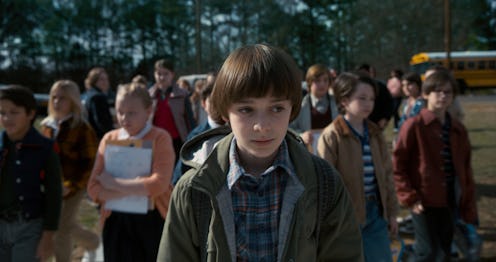Entertainment
Why This ‘Stranger Things’ Fan Theory Isn’t Actually That Far Off The Mark

There was much speculation among fans ahead of Season 2 about what the giant shadow monster featured in the Stranger Things promotions was. One of the most popular theories that quickly took root was another Dungeons & Dragons reference — which wouldn't have been out of the realm of possibility, given the fact that last year's enemy was referred to as the "Demogorgon," a term coined by the fantasy game. Some fans saw what seemed to be the many limbs of the shadow monster and inferred that perhaps it was a Thessalhydra —a multi-headed monster that the kids even reference while playing D&D in the first season. So does a Thessalhydra make an appearance in Stranger Things 2? Spoilers ahead!
As it turns out, the show doesn't reference the Thessalhydra quite as much as some fans were anticipating. It's never referred to as that specific name by the kids — if they refer to it by name at all, they call it the shadow monster or in some variation of general terms. They don't name it quickly like they did the Demogorgon last season. Much of this is probably because the shadow monster is only really visible to Will, other than the glimpse Eleven and Hopper get of it as she closes the tear in the final episode. It's not really anything tangible for the other boys to see, and Will is far too busy getting scarred for life by a weird virus possession to be giving his nightmares clever Dungeons & Dragons nicknames.
People were pretty adamant about the Thessalhydra theory. In fact, some users of the Reddit forum dedicated to the show have been referring to the monster exclusively as the Thessalhydra for a while now. It fits, if you think about it — the Thessalhydra character in Dungeons & Dragons has eight heads, and it wouldn't be hard to assume — given the unclear look we were first given of the shadow monster that the same is true for it. There was even Thessalhydra speculation based on how many lives had allegedly been claimed by the Upside Down. As Redditor DarrellJones posted last year, perhaps the number of people who had gone missing correlated to the number of heads the monster had.
"All of them are actually parts of the Thessalhydra, Hydra being many headed creatures. At some point we get to see them all melt together into one creature," the user wrote. "The question of whether [Will] is part of this creature or not could be a theme of the season, like things always happen when he is in the vicinity and unobserved. Maybe he's also having blackouts and can't remember where he's been."
Some weren't as convinced about the Thessalhydra theory, but no one seemed to have exactly pinned down what the monster proved to be.
"I don't think there will be a new monster by any means," user placexholder wrote last year. "I think the reference to D&D isn't as important as some think it is. Moreso, the eggs and larvae will just create more of the demogorgons if not taken care of, which I believe we will see in season 2. [The] idea of a new monster would be cool but I don't see how it would help the longevity and popularity of the show if they were to rinse and repeat a new monster each season."
While the shadow monster definitely looks like a Thessalhydra from afar, viewers don't really get the vibe that it has multiple heads — more like one, very daunting and sinister head, and many limbs. If anything, it resembles the vines and maze of pathways under the town of Hawkins more than it does a reptilian creature. It's also worth noting that though the show does bring in this new monster, it isn't without reintroducing fans to new variations of the enemies from last season — the dog-like demogorgon creatures of this season proved that old dangers still loom.
That's not to say there isn't Thessalhydra inspiration here — the monster still remains largely a mystery even after Season 2, and it's definitely still lurking around the Upside Down. Perhaps next season will bring a little more light to what exactly this thing is.